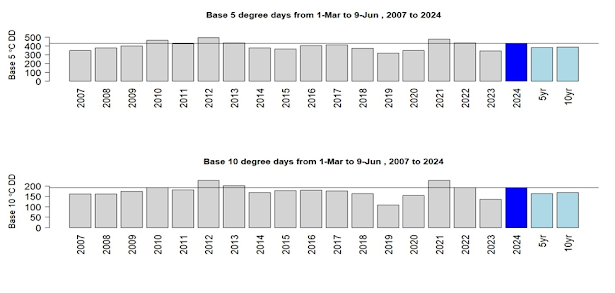Hello,
everyone
In this quick
mid-week update, we show some highlights from a recent wild blueberry growers
meeting.
-
Kentville
Degree Day Accumulations
-
NS
Wild Blueberry Weather Stations GDD Accumulations
-
Spreading
Dogbane Management in Wild Blueberry Fields
Kentville Degree Day Accumulations
Figure
1: Heating degree day accumulations for plant
(above 5°C) and insect (above 10°C) development from March 1 to June 9 for the
past 17 seasons. Provided by Jeff Franklin (AAFC Plant Physiology).
As
of June 9, this year’s GDD accumulation trend in NS is still ahead of the
provincial 5- and 10-year averages. Table 1 shows the difference between the 2024 and 5-year average is about 50 (433.3-385). At this time of the year, we gain about
12 GDD daily across the province. That’s about 4.2 days earlier than our normal
management schedule.
Table
1. Degree day
accumulations as of June 9, 2024. All data are taken from the Environment and
Climate Change Canada weather station located at the Kentville Research and
Development Centre. Calculations are based on a start date of March 1 and
calculated using the single-sine method.


Wild Blueberry GDD Updates_ April 1- June 10
Figure 2. GDD Summary, April 1-
June 10
Spreading Dogbane Management in Wild Blueberry Fields
Figure 3. Spreading Dogbane with
flowers and leaves
Spreading Dogbane
(Apocynum androsaemifolium L.) is a perennial plant and a troublesome weed in
wild blueberry fields. In a 2017-2019 weed survey, this weed appeared in about
20% of the total wild blueberry fields in NS. Over the last few years, we have
been noticing that this weed is spreading very fast and the occurrence of this
plant in blueberry fields is increasing. The primary spreading method of dogbane
is via horizontally growing roots which helps to form ever-expanding patches of
dense shoots (Figure 4).
Figure 4. Dense Spreading Dogbane
Patch in an infested wild blueberry field
Cutting,
mowing, round up applications, and using Dicamba products (Banvel and Engenia)
are all common from past conversations with growers. They have their own pros
and cons. I only discuss further the industry-standard and research-based recommended
management practices.
Growers
can access Banvel and Engenia at the moment. Dicamba products will hurt wild
blueberry plants so we only recommend spot spray the recommended products in
wild blueberry fields. The initial application is recommended when dogbane
patches are in the early bud stage (Figure 5). Further applications might be
needed. A sticker/adjuvant is recommended to improve product efficacy and
control results. Please read the product label. The below information
is just some quick numbers (Figure 6) to help you to cross-check. Please also
go through sections in the label including mixing instructions and spraying instructions
to avoid any factors that might affect product efficacy.
Figure 5. Spreading Dogbane in
Early Bud Stage
Figure 6. Recommended Product Rates
for Spreading Dogbane Management
Have a great week!
Hugh







